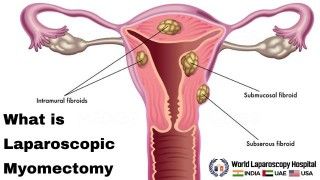Step-by-step demonstration of laparoscopic hysterectomy and appendectomy illuminated ureteral stent
Add to
Share
1,237 views
Report
2 years ago
Description
Introduction: Surgical procedures have witnessed remarkable advancements in recent years, driven by the pursuit of improving patient outcomes and reducing post-operative complications. Laparoscopic surgery, also known as minimally invasive surgery, has revolutionized the field by offering numerous benefits over traditional open procedures. In this essay, we will explore the step-by-step demonstration of two laparoscopic surgeries - hysterectomy and appendectomy - performed with the aid of an illuminated ureteral stent. This innovative technique highlights the advancements in surgical precision and patient care. Body: Laparoscopic Hysterectomy: Hysterectomy, the surgical removal of the uterus, has traditionally been performed using an open approach, resulting in longer hospital stays, increased pain, and a higher risk of complications. However, laparoscopic hysterectomy has emerged as a superior alternative, providing enhanced precision and improved patient outcomes. a) Introduction of laparoscopic approach: Laparoscopic hysterectomy involves making several small incisions in the abdomen, through which a laparoscope and specialized instruments are inserted. The laparoscope provides a magnified view of the surgical field, allowing surgeons to navigate and perform the procedure with increased accuracy. b) Utilizing an illuminated ureteral stent: The inclusion of an illuminated ureteral stent further enhances surgical precision. The stent is placed in the ureter, the tube connecting the kidneys to the bladder, and emits light, providing real-time visualization of the ureter throughout the procedure. This ensures that the ureter remains protected and reduces the risk of injury during the surgery. c) Step-by-step demonstration: Surgeons meticulously demonstrate each step of the laparoscopic hysterectomy, showcasing the precise dissection of tissues, careful removal of the uterus, and closure of incisions. The illuminated ureteral stent plays a crucial role in guiding surgeons away from the ureter, safeguarding its integrity and preventing post-operative complications. Laparoscopic Appendectomy: Appendectomy, the surgical removal of the appendix, is a commonly performed procedure to treat appendicitis. Similar to laparoscopic hysterectomy, laparoscopic appendectomy offers several advantages over open surgery, including reduced pain, faster recovery, and decreased risk of infection. a) Laparoscopic approach in appendectomy: Laparoscopic appendectomy involves the insertion of a laparoscope and specialized instruments through small incisions in the abdomen. The laparoscope provides a clear view of the appendix and surrounding structures, allowing surgeons to precisely identify and remove the inflamed or infected appendix. b) Role of illuminated ureteral stent: In the case of laparoscopic appendectomy, the illuminated ureteral stent aids in visualizing the ureter, which runs close to the appendix. Surgeons can navigate and perform the procedure while minimizing the risk of unintentional injury to the ureter. c) Step-by-step demonstration: Surgeons demonstrate the meticulous steps involved in laparoscopic appendectomy, from the identification of the inflamed appendix to the careful removal and closure of the incisions. The illuminated ureteral stent ensures that the ureter remains protected throughout the procedure, reducing the likelihood of complications. The step-by-step demonstration of laparoscopic hysterectomy and appendectomy with the aid of an illuminated ureteral stent highlights the cutting-edge advancements in surgical precision and patient care. Laparoscopic surgery, known for its minimally invasive approach, has revolutionized traditional open procedures, offering improved outcomes and reduced complications. This innovative technique combines the use of a laparoscope and an illuminated ureteral stent to provide real-time visualization and enhance surgical accuracy. During a laparoscopic hysterectomy, small incisions are made in the abdomen, allowing surgeons to insert a laparoscope and specialized instruments. The illuminated ureteral stent is placed in the ureter, emitting light that guides surgeons away from the ureter and minimizes the risk of injury. This meticulous step-by-step demonstration showcases the precise dissection of tissues, removal of the uterus, and closure of incisions, ensuring patient safety and optimal outcomes. Similarly, laparoscopic appendectomy involves the removal of the appendix through small incisions. The laparoscope provides a clear view of the inflamed appendix and surrounding structures, while the illuminated ureteral stent assists in visualizing the nearby ureter, minimizing the risk of unintended harm. Surgeons demonstrate the careful identification and removal of the appendix, ensuring a successful procedure and quicker recovery. The use of an illuminated ureteral stent in both laparoscopic hysterectomy and appendectomy demonstrates the commitment to advancing surgical precision and patient safety. By providing real-time visualization and guidance, the risk of complications and post-operative issues is significantly reduced. This technique showcases the continuous evolution of medical technology, promising a future where patients can benefit from safer and more effective surgical procedures. Overall, the step-by-step demonstration of laparoscopic hysterectomy and appendectomy with an illuminated ureteral stent underscores the remarkable advancements in surgical precision. This approach not only improves patient outcomes but also contributes to the overall progress of minimally invasive surgery. As medical technology continues to advance, the future holds great promise for further refining these procedures and enhancing patient care. Conclusion: The step-by-step demonstration of laparoscopic hysterectomy and appendectomy with the aid of an illuminated ureteral stent showcases the advancing surgical precision in minimally invasive procedures. By incorporating this innovative technique, surgeons can perform these surgeries with enhanced accuracy, reduced risk of complications, and improved patient outcomes. The utilization of a laparoscope and an illuminated ureteral stent allows for real-time visualization, ensuring the safety of critical structures, such as the ureter. As technology continues to evolve, these advancements in surgical precision promise a brighter future for patients undergoing laparoscopic procedures, offering them safer and more effective treatment options.
Similar Videos






